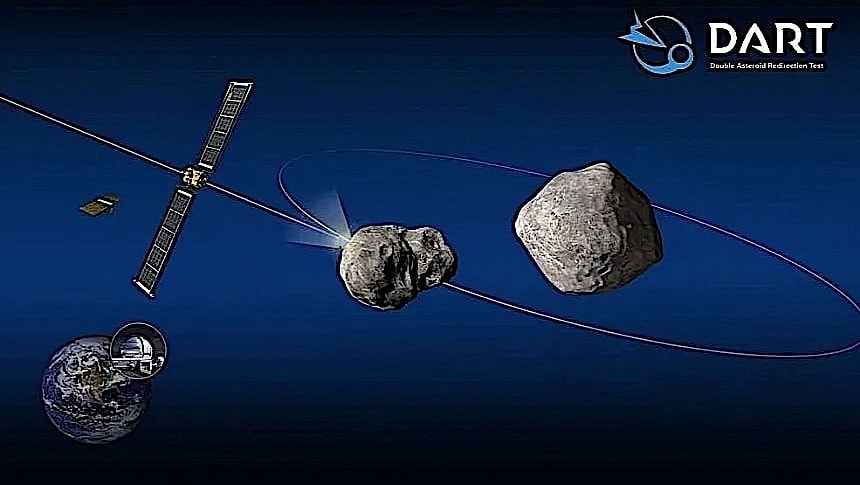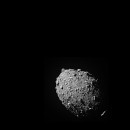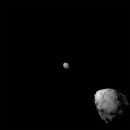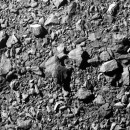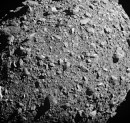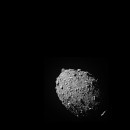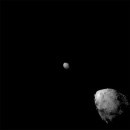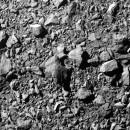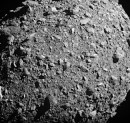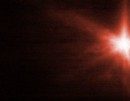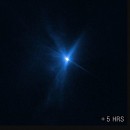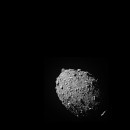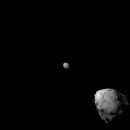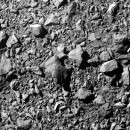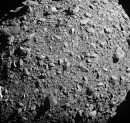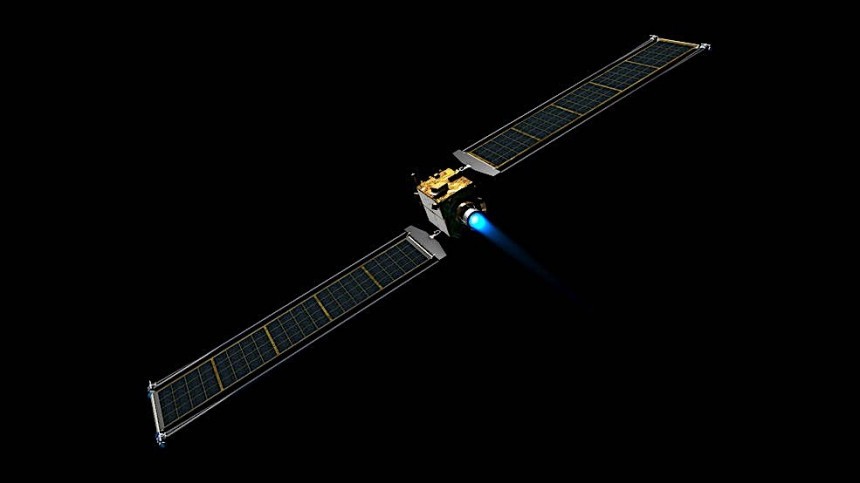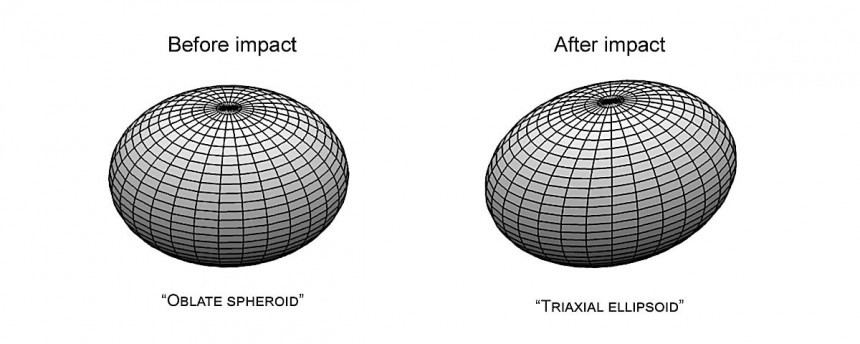In late 2021 our species launched the first space weapon against a killer asteroid. Ok, it was not exactly a space weapon, and its target was nothing more than an innocent piece of space rock floating in space with no malintent toward us, but the mission did prove a point: if it really comes down to it, we could theoretically defend ourselves against mass extinction events caused by asteroids.
The mission I'm talking about was called Double Asteroid Redirection Test, or DART. It launched in November 2021 on top of a SpaceX Falcon 9 rocket. Less than a year later, in September 2022, it reached and struck its target, a binary asteroid system called 65803 Didymos.
DART was technically a spacecraft with a mass of 1,340 pounds (610 kg). It was propelled by a solar-powered electric propulsion system comprising a gridded ion engine (NASA's Evolutionary Xenon Thruster–Commercial, or NEXT–C). The American space agency, however, did not call it spacecraft, but a kinetic impactor. We'll see in a bit why.
The Didymos binary system is a pair of asteroids that back in 2022 were floating around in space at a distance of about seven million miles (11 million km) from Earth. The system comprises a large asteroid called Didymos measuring half a mile in diameter (760 meters), and a smaller one that orbits it like a Moon. Called Dimorphos, this one is 560 feet (170 meters) in diameter and it was the target of the DART kinetic impactor.
When it reached its destination, DART slammed into Dimorphos at speeds of about 14,000 mph (22,530 kph). It did that as NASA was trying to see if this approach could be effective in altering the course of an asteroid heading for Earth, or potentially even destroy it in the process.
Because of the distance from Earth at which the impact occurred and the absence of another spacecraft in the vicinity, we don't really know how it all unfolded and what the exact effects are. However, distant observation points to the fact that the punch humanity gave the small asteroid moon was quite forceful.
The mighty James Webb Space Telescope and its veteran sibling Hubble were quickly pointed at Dimorphos both during and after the strike, and they observed a compact core of light from which plumes of material emerged. That's ejecta caused by the strike. Based on the observations of the two telescopes, scientists think the brightness of the asteroid increased by three times as a result of the strike and the thing kept glowing for eight hours after that.
Later observations with Hubble showed a bright debris cloud hanging over the space rock. More importantly than that, the orbit of Dimorphos around Didymos had changed, and the speed of its movement increased. It was determined that instead of 11 hours and 55 minutes to complete a full orbit, the small asteroid now does it in 11 hours and 22 minutes.
And this week came news of what DART did to Dimorphos in terms of shape. And it seems the strike was so powerful that it even changed that.
Before the Earth spacecraft reached it, the asteroid was, according to measurements taken from afar, an oblate spheroid. That is something like a symmetrically squashed ball, wider than it is tall. It moved around its parent in a circular orbit, at a distance of 3,900 feet (1,189 meters).
DART hit it so hard that the rock is now a triaxial ellipsoid, something that can be likened to an oblong watermelon. The shape of its orbit has changed as well, going from circular to slightly elongated. On top of that, the orbit itself is now closer, standing at about 3,780 feet (1,152 meters).
At least that's the conclusion of the authors of a study that was recently published in the Planetary Science Journal. Using data from the DART spacecraft itself (before it was destroyed, of course), Earth-based radars, and ground telescopes, the team is confident the mission far exceeded its objectives.
As for how DART modified the appearance of the asteroid, that's impossible to determine at the moment. We will however get a pretty decent look sometime in 2027.
Later this year the European Space Agency (ESA) plans to launch a mission called Hera. It too targets the Didymos – Dimorphos pair, but with a different goal in mind: see what a mess DART made of the place.
Comprising a carrier spacecraft and two CubeSats called Milani and Juventas, the Hera mission will hit the surface of the target asteroid with radar and other instruments to get a proper sense of the damage. And it is then and only then that we will be able to get a proper sense of our capabilities.
Hera is at the moment scheduled to depart our planet in October 2024 on board a SpaceX Falcon 9 rocket.
DART was technically a spacecraft with a mass of 1,340 pounds (610 kg). It was propelled by a solar-powered electric propulsion system comprising a gridded ion engine (NASA's Evolutionary Xenon Thruster–Commercial, or NEXT–C). The American space agency, however, did not call it spacecraft, but a kinetic impactor. We'll see in a bit why.
The Didymos binary system is a pair of asteroids that back in 2022 were floating around in space at a distance of about seven million miles (11 million km) from Earth. The system comprises a large asteroid called Didymos measuring half a mile in diameter (760 meters), and a smaller one that orbits it like a Moon. Called Dimorphos, this one is 560 feet (170 meters) in diameter and it was the target of the DART kinetic impactor.
When it reached its destination, DART slammed into Dimorphos at speeds of about 14,000 mph (22,530 kph). It did that as NASA was trying to see if this approach could be effective in altering the course of an asteroid heading for Earth, or potentially even destroy it in the process.
Because of the distance from Earth at which the impact occurred and the absence of another spacecraft in the vicinity, we don't really know how it all unfolded and what the exact effects are. However, distant observation points to the fact that the punch humanity gave the small asteroid moon was quite forceful.
Later observations with Hubble showed a bright debris cloud hanging over the space rock. More importantly than that, the orbit of Dimorphos around Didymos had changed, and the speed of its movement increased. It was determined that instead of 11 hours and 55 minutes to complete a full orbit, the small asteroid now does it in 11 hours and 22 minutes.
And this week came news of what DART did to Dimorphos in terms of shape. And it seems the strike was so powerful that it even changed that.
Before the Earth spacecraft reached it, the asteroid was, according to measurements taken from afar, an oblate spheroid. That is something like a symmetrically squashed ball, wider than it is tall. It moved around its parent in a circular orbit, at a distance of 3,900 feet (1,189 meters).
DART hit it so hard that the rock is now a triaxial ellipsoid, something that can be likened to an oblong watermelon. The shape of its orbit has changed as well, going from circular to slightly elongated. On top of that, the orbit itself is now closer, standing at about 3,780 feet (1,152 meters).
As for how DART modified the appearance of the asteroid, that's impossible to determine at the moment. We will however get a pretty decent look sometime in 2027.
Later this year the European Space Agency (ESA) plans to launch a mission called Hera. It too targets the Didymos – Dimorphos pair, but with a different goal in mind: see what a mess DART made of the place.
Comprising a carrier spacecraft and two CubeSats called Milani and Juventas, the Hera mission will hit the surface of the target asteroid with radar and other instruments to get a proper sense of the damage. And it is then and only then that we will be able to get a proper sense of our capabilities.
Hera is at the moment scheduled to depart our planet in October 2024 on board a SpaceX Falcon 9 rocket.
